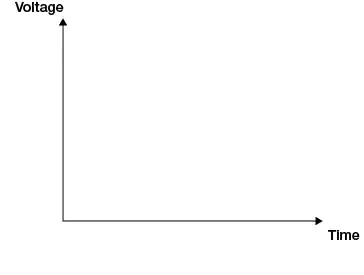This calculator is used to calculate the discharge of a capacitor through a fixed-value resistor. This calculator solves for time or resistance, measuring the resulting initial power dissipation in the resistance and the total energy discharged to zero volts, given a capacitance value and beginning and end voltages.
Capacitor Safety Discharge Calculator

How does this calculator work:
The Capacitor Discharge Calculator defines the voltage at which a capacitor with a capacitance of C and a resistor in series with it can discharge after a period of time, t. This calculator can be used to estimate the voltage at which the capacitor would have discharged after a time span of t has passed.
To measure the voltage across the capacitor, we need to know the initial voltage, V0, across the capacitor before the discharging starts, the capacitance, C, of the capacitor, the resistor, R, in series with the capacitor, and the amount of time since the discharging started. Once we have these, we can use the formula above to measure the voltage around the capacitor.
How to measure:
Except for the one you want to measure, fill in all of the values.
from voltage - the capacitor's initial voltage
to voltage - the capacitor's voltage after a period of time has passed.
The voltage of the power supply is referred to as supply voltage. This may also be zero to signify a limited period of time.
Capacitance - The capacitor's capacitance.
The resistor's resistance is called resistance.
Time - The amount of time it takes to charge or discharge a device.
Time, t, the resistance of the resistor, R, and the capacitance of the capacitor, C, are the three variables that influence how the initial voltage discharges.
The more the time has passed, the more the capacitor can discharge. The capacitor has less time to discharge the less time has passed. As a consequence, the lower the VC, the higher the t value. The slower the discharge mechanism is, the higher the resistor's resistance, R. This is due to the fact that resistance reduces the amount of current that passes through it. The capacitor discharges more slowly if the resistance is high. The greater the VC, the higher the resistance value. The VC will be smaller if the resistance is low.
The discharge mechanism would be slower the larger the capacitor's capacitance. This is due to the fact that the higher the capacitance, the more charge is stored in the capacitor. If it has a higher fee, it may take longer to discharge it fully. It carries less charge if the capacitance is lower. As a consequence, discharging the charge takes less time. As a consequence, the higher the capacitance value, the higher the VC. The VC will be smaller if the capacitance is higher.
The voltage across the capacitor is given by the value of the equation result, which is VC. The resulting voltage is expressed in volts (V).
How do you calculate the discharge of a capacitor?
Discharge of a capacitor through a resistor Capacitor discharge (voltage decay): V = Voe-(t/RC) Capacitor discharge (charge decay): Q = Qoe-(t/RC) V = Voe-(t/RC) and also I = Ioe-(t/RC) Q = Qoe-(t/RC) Capacitor charging (potential difference): V = Vo[1-e-(t/RC)]
How do you safely discharge a capacitor?
Another way to discharge a capacitor would be to source an incandescent light bulb that can tolerate the voltage held in the capacitor. Hook this up and once the bulb is no longer lit, the capacitor is discharged. Again, you always want to measure the voltage after it's supposedly discharged just to be safe.
How long will a capacitor take to discharge?
After 5 time constants, the capacitor will discharge to almost 0% of all its voltage. After 5 time constants, for all extensive purposes, the capacitor will be discharged of nearly all its voltage. A capacitor never discharges fully to zero volts, but does get very close.
Does discharging a capacitor ruin it?
To discharge a capacitor there must be a circuit, a loop, that passes through both terminals of the capacitor. In regard to the "health" of the capacitor, high discharge currents can damage it or reduce its lifespan, so it is favorable to discharge through a resistor.
How do you calculate the initial discharge of a capacitor?
A capacitor with capacitance 0.1F in an RC circuit is initially charged up to an initial voltage of Vo = 10V and is then discharged through an R=10Ω resistor as shown. The switch is closed at time t=0. Immediately after the switch is closed, the initial current is Io =Vo /R=10V/10Ω.
Is it safe to discharge a capacitor with a screwdriver?
It's often safe to discharge a capacitor using a common insulated screwdriver; however, it is usually a good idea to put together a capacitor discharge tool and use that for electronics with larger capacitors such as household appliances.
What is discharging of capacitor?
Discharging means, the capacitor giving up the stored charge in it. Let us assume, the voltage of the capacitor at fully charged condition is V volt. As soon as the capacitor is short circuited, the discharging current of the circuit would be, – V / R ampere.
What happens when a capacitor is discharging?
If a capacitor is discharging, current exits the more positive terminal rather than entering. That's really all there is to it. When current enters the more positive terminal, power is delivered to the capacitor and, thus, the stored energy increases.
Why do capacitors need to be discharged?
A capacitor can be slowly charged to the necessary voltage and then discharged quickly to provide the energy needed. It is even possible to charge several capacitors to a certain voltage and then discharge them in such a way as to get more voltage (but not more energy) out of the system than was put in.
How long does a capacitor take to discharge?
A fully charged capacitor discharges to 63% of its voltage after one time period. After 5 time periods, a capacitor discharges up to near 0% of all the voltage that it once had. Therefore, it is safe to say that the time it takes for a capacitor to discharge is 5 time constants.
| Image | Part Number | Manufacturer | Category | Package/Case | Description | Price | Quantity | Buy/Quote |
|---|---|---|---|---|---|---|---|---|
 | BLM18PG121SN1D | Murata Electronics | Ferrite Beads and Chips | 0603 (1608 Metric) | MURATA - BLM18PG121SN1D - Ferrite Bead, 0603 [1608 Metric], 120 ohm, 2 A, BLM18P Series, 0.05 ohm, ± 25% | - | In stock : 355131 Minimum: 1 | |
 | TP3420AV309 | Texas Instruments | Interface - Telecom | 20-LCC (J-Lead) | IC TELECOM INTERFACE 20PLCC | - | In stock Minimum: 1 | |
 | 2920L185DR | Littelfuse Inc. | PTC Resettable Fuses | 2920 (7351 Metric), Concave | PTC RESET FUSE 33V 1.85A 2920 | - | In stock : 7500 Minimum: 1 | |
 | 19-217/R6C-AL1M2VY/3T | Everlight Electronics Co Ltd | LED Indication - Discrete | 0603 (1608 Metric) | LED RED CLEAR 2SMD | - | In stock : 6070 Minimum: 1 | |
 | MPZ2012S102AT000 | TDK Corporation | Ferrite Beads and Chips | 0805 (2012 Metric) | TDK - MPZ2012S102AT000 - FERRITE BEAD, 0.15OHM, 1.5A, 0805 | - | In stock : 51745 Minimum: 1 | |
 | MC33153P | ON Semiconductor | PMIC - Gate Drivers | 8-DIP (0.300, 7.62mm) | IC DRIVER GATE SINGLE IGBT 8DIP | - | In stock : 1000 Minimum: 1 | |
 | SE2537L-R | Skyworks Solutions Inc. | RF Amplifiers | 16-VFQFN Exposed Pad | RF Amplifier 5GHz Gain 30 dB 3.3Volt -10C 85C | - | In stock : 4525 Minimum: 1 | |
 | SKY81294-14-001 | Skyworks Solutions Inc. | PMIC - LED Drivers | 9-BGA, WLCSP | IC LED FLASH DVR 1.2V 9CSP |
| In stock : 1786 Minimum: 1 | |
 | SKY65084-360LF | Skyworks Solutions Inc. | RF Amplifiers | 8-VFDFN Exposed Pad | IC AMP 1.5-2.4GHZ LN 8QFN | - | In stock Minimum: 1 | |
 | HMC588LC4BTR | Analog Devices Inc. | RF Misc ICs and Modules | 24-TFQFN Exposed Pad | IC OSC VCO WIDEBAND 24SMD | - | In stock : 5200 Minimum: 1 | |
 | MC1458D | ON Semiconductor | Linear - Amplifiers - Instrumentation, OP Amps, Buffer Amps | 8-SOIC (0.154, 3.90mm Width) | IC OPAMP GP 2 CIRCUIT 8SOIC |
| In stock : 67 Minimum: 1 | |
 | 80HCPS1432CRM | Renesas Electronics America Inc. | Specialized ICs | 576-BBGA, FCBGA | IC SER RAPIDIO SWITCH 576FCBGA | - | In stock Minimum: 1 | |
 | MAX16816ATJ | Maxim Integrated | PMIC - LED Drivers | 32-WFQFN Exposed Pad | IC, LED DRIVER, BUCK-BOOST, TQFN-32 | - | In stock Minimum: 1 | |
 | DS21Q48N | Maxim Integrated | Interface - Telecom | 144-BBGA | IC LIU E1/T1/J1 4X 5V LONG144BGA | - | In stock Minimum: 1 | |
 | ALT6702RM45Q7 | Skyworks Solutions Inc. | RF Amplifiers | - | IC RF AMP CELLULAR SMD | - | In stock Minimum: 1 | |
 | LQH2HPN4R7MGRL | Murata Electronics | Fixed Inductors | 1008 (2520 Metric) | Fixed Inductors 1008 4.7uH 1000mA /-20% | - | In stock : 216000 Minimum: 1 | |
 | VLS252012HBX-2R2M-1 | TDK Corporation | Fixed Inductors | 1008 (2520 Metric) | FIXED IND 2.2UH 2.3A 102 MOHM | - | In stock : 19980 Minimum: 1 | |
 | GRM188R61A106KAALD | Murata Electronics | Ceramic Capacitors | 0603 (1608 Metric) | CAP CER 10UF 10V X5R 0603 |
| In stock : 897263 Minimum: 5 | |
 | GRM0335C1E102GA01D | Murata Electronics | Ceramic Capacitors | 0201 (0603 Metric) | CAP CERAMIC 0.001UF 25V C0G 2% P | - | In stock : 1160 Minimum: 1 | |
 | EEF-CS1E150R | Panasonic Electronic Components | Aluminum - Polymer Capacitors | 2917 (7343 Metric) | Aluminum Organic Polymer Capacitors 15uF 25volt |
| In stock : 80000 Minimum: 1 |
